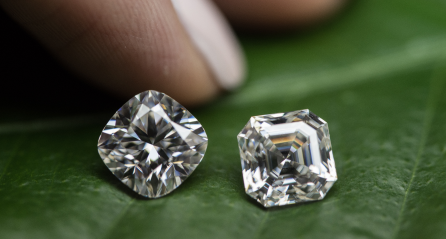Diamond Color
In this guide you will discover:
- How colors are graded
- The color chart explained
- Our advice to use color to select a high quality diamond
- An education video made by GIA on diamond color grading
- Fluorescence , why it matters
Diamond color
After diamond cut , color is the second most important quality aspect to consider when choosing a diamond. The diamond color has a big impact on its appearance. Due to the many prismatic facets a colorless diamond will have much more "fire" ( will reflect more light). If color is present in the diamond this ability to reflect light will be reduced.
This is the main reason why the most valuable diamonds have little to no detectable color.
Find below our tips to select the best colors for your budget.
Color grading
Diamonds are graded under very precise viewing conditions and often compared to a diamond of a known color grade to ensure very few differences within a color grade.
A diamond absent of color is grade ‘D’ and the more color that is present in the diamond, the further along the alphabet it’s grade travels. Diamond with grade ‘Z’ will have a light yellow or brown tint, and therefore will not reflect light as well as a colorless diamond. D-Z diamonds are sometimes also referred to as white diamonds.
Fancy colored diamonds, although most are irradiated and color enhanced, do not follow this grading scale, and often are less valuable because when naturally colored they are extremely rare. The most common color grades are G through I, as they are more abundant in nature, and thus much more affordable.
Although diamonds of these grades does have a hint of color, it generally isn’t visible to the naked and untrained eye.
White gold or platinum settings usually require higher grade color diamond, whereas a yellow gold setting takes away from the yellow tint of a lower grade diamond.
Most jewelers use the GIA Diamond Color Grading Scale, and it’s recommended for customers to do the same to better understand the subtle differences in color a diamond may have, and to better assess the quality and value of a diamond.
Diamond color chart
The diamond color chart begins at D (colorless) and ends at Z (light yellow)
D and E colors are considered 'Exceptional White + ( D) and Exceptional White ( E). To the naked eye, any color above (I ) color can be considered colorless. I and J colors carry a slight trace of color (generally a slight yellowish tint).
Any color below J has a Clear trace of color ( a non negligible yellow tint ).
It is imperative to have comparison brilliants in order to grade colors visually. It is important to have the low ( or high ) end of each color, in order to match the diamond in question to its right color. It is also important to compare diamonds under 'white light' and against a white background, in order to be accurate.

- D colored diamonds are the rarest and totally colorless. Also the most valuable (expensive).
- E colored diamonds are jut slightly lower than D. Almost colorless, pretty much non-distinguishable from D in broad daylight.
- F is the whitest of colors which contains a very slight tint of yellow. Again not noticeable to the untrained eye. Still a premium color at a discounted price when compared to D or E.
- G is considered Top White. Does have a tint. A perfect compromise and very popular choice.
- H is the last of the White colors. Not detectable to the naked eye, but will be noticed when compared to the higher colors. Commercial white is its common name.
- I is Tinted White. Much less rare and inexpensive than the Whites. Will not put a dent in your wallet.
- All ratings below I are considered Yellowish.
Tips to use color to find your perfect diamond
- Compared to other shapes , brilliant round-cut diamonds appear brighter due to greater light reflection.
- If you prefer a colorless diamond you should choose a stone in the D-F range with fluorescence rating of none or faint.
- Near colorless diamonds with a rating between G and I provide excellent values as their color is undetectable for the untrained eye. These diamonds are perfect to set in platinum or white gold metals.
Diamond fluorescence
Fluorescence, the effect ultraviolet (UV) light has on a diamond, is an important consideration when selecting a diamond. When UV light strikes a diamond with fluorescent properties, the stone emits a glow (usually blue) ranging from very faint to quite strong.Colorless (D-F) fluorescent diamonds ;sell at up to a 15% discount since the fluorescence is perceived as a defect.
The bottom line
While color is one of the 4c's its has maybe the least impact on the quality of the diamond. As most diamonds are set in Jewels for these diamonds color might be the one characteristic you can compromise on.
The color grading of diamonds: a GIA education video
The Gemological Institute of America's (GIA) color grading system is the diamond industry's standard for diamond color grading. The GIA's color grading system begins with D, being the whitest, and continues through the alphabet to Z, for stones that are yellowish or brownish. Before the GIA developed their universal diamond color grading standard several other color scales were being used by the international diamond community. The GIA's intention was to completely differentiate their new system from the others. As such, they chose letters D-Z, letters that had never been used for diamond grading before.
How our selection of diamonds makes your decision easier
We understand that finding and selecting the right diamond is not an easy task. That's why we have selected to offer MAINLY I and better graded diamonds. This way you are ensured that whatever diamond you select on our site will be of a good quality.
If you ever would like to buy a diamond of a lesser color , feel free to contact us for our best offer or advice.








